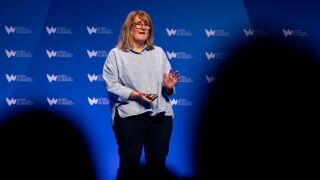Ahead of his panel session on capitalising the cloud and edge, Capacity spoke to Raul Martynek of DataBank about the future of edge connectivity, starting with the acceleration of the migration to the cloud due to Covid.
“All the pandemic did was accelerate trends that were already occurring,” says Martynek. “It was something of a double-edged sword, because you had customers who had already deployed their edge connectivity and needed to expand because of increased demand on their digital services.”
The other side of the experience was the things like the lockdowns and travel restrictions which slowed down new deployments.
“So what we’ve seen in 2021, with the lifting of a lot of these restrictions, is a lot of that digital demand that is still benefiting more traditional markets, but we are also seeing new projects show up that were put on hold in 2020.”
Across its footprint of 58 data centres in 25 markets in the US, the largest geographic footprint of any data centre operator in America, edge is becoming much-needed, not just in the most densely populated regions but all across the country.
“What we’re seeing is that customers that, say, three years ago might have only deployed edge in the West Coast, in the centre of the country or in east of the country, now they are saying we need to be in not three locations, but eight or 10 locations.”
One saviour of the restrictions placed on the movement of people over the past 18 months has been automation, with the likes of zero-touch provisioning and software-defined applications becoming more prevalent than ever before.
In the case of DataBank, as a self-described provider of space and power, Martynek says there are applications for such automation higher up the stack.
“That’s the way people are thinking about their application, as a collection of nodes that are redundant to each other, that requires orchestration and automation,” he says.
“What we are doing at DataBank is at the connectivity perspective level. We are in the process of developing a connectivity fabric to interconnect a select number of data centre locations, so that from a networking perspective customers can more seamlessly deploy infrastructure.”
The news comes as Martynek witnesses more data centre providers recognising this type of interconnectivity as an important component that creates value in their properties, and a desire to invest in this type of solution.
This in part is due to the advent of the cloud and all of those automation tools that came with it that have “begun to socialise customers to be comfortable with that idea of automating and using more software to manage its infrastructure,” according to JP Laqueur, SVP of marketing at DataBank.
Other technologies that also making waves at the moment include AI and machine learning, “which manifests itself in what we call high-performance computing platforms,” says Martynek
“We are seeing those types of workloads appear in our data centres, but they still require a huge degree of technical competency to glean any benefits from them, so I would say it’s still a very small subset of customers – roughly 5%.”
As for the extremely advanced processing generated from things such as quantum computing, he says that it’s still early days, with little to no real presence in its traditional data centres, “we think that’s still very much a lab type of product.”
Another aspect of DataBank’s business is content delivery networks (CDNs) that Martynek describes as “a very important customer class for us”.
Aside from geographic diversity, those looking for CDN solutions also require security – as do all those in the technology and enterprise space. In light of highly publicised outages of Fastly and Akamai earlier this year (more in the August issue of Capacity) Martynek sees it as a consequence of more applications and activity becoming more digital, as opposed to anything specific that needs to be addressed with CDNs.
And as Laqueur says: “It’s part of the reason we built out a pretty robust set of managed security services. The attack surface expands as a function of that increased digitisation, which means that we’re going to be in this cycle for a very long time,” he says.
Though 80% of DataBank’s business is space and power, the remaining 20% is devoted to connectivity and managed services. The security part of this offering includes a dedicated security organisation run by a chief information security officer, which applies the FedRAMP government standard for the securing of data across its co-location and cloud environment.
“On the managed services side we have security tools like DDoS prevention, IDS, IPS, file integrity monitoring, anti-virus, anti-ransomware and malware,” adds Martynek.
One other aspect of the edge ecosystem is that of subsea, which many have begun to question the effect one will have on another – namely, will edge lead to less subsea? But that would only happen if, as Martynek says, we get to the point when data no longer travels across continents.
“Take Europe, which has roughly 370 million people. How can you ever believe that you can think about all the data that they might want to access and somehow place that on the European continent so that they don’t have to reach out to Asia, America or Africa for different things.”
The bigger question, according to Laqueur is “where does that data become connected and exchanged because that changes the network topology to become more peering and edge-based, but at some point that data has still got to be moved, it has still got to be replicated, it has still got to be shared.”
Gaming is also a big disruptor of the space, with Martynek describing it as probably one of the new kind of real-world applications that generate money today.
“Gaming is probably best positioned to take advantage of kind of the ultra-low latency that will evolve as the world moves to 5G,” he says.
“We see gaming companies in the US, expanding out their geography, going from a smaller number of pins on the map to a larger number of pins on the map to take advantage of that. Gaming will be also be one of the first to take advantage of this new distributed infrastructure, specifically this new edge infrastructure that will evolve.”
Having closed on the acquisition of zColo earlier this year as well as an investment of US$30 million in US modular data centre company EdgePresence, DataBank is positioning itself to deliver on the future needs of its customers.
“What is the edge? We asked ourselves that question and ultimately, we came to the conclusion that it is a real phenomenon, and that is about the decentralisation of infrastructure,” Martynek says.
“We felt that adding more geography through the zColo acquisition was going to position us to take advantage of this macro trend.”
Part of this is EdgePresence, because infrastructure is going to be required in a lot more highly geographic-specific locations where they don’t have the same amount of capital to create a major data centre.
“EdgePresence is basically a mini data centre that you can deploy almost anywhere, so the threshold to deploy it is much lower with the same levels of security, compliance, carrier-neutral and 100% available from a power and crew perspective.”
Now months into the integration of these businesses along with its various connectivity projects, it is evident that DataBank is banking on edge.






